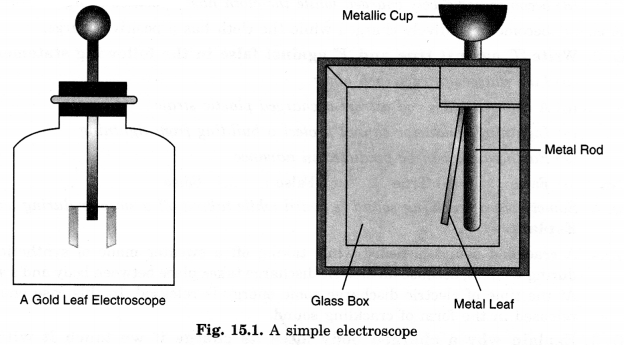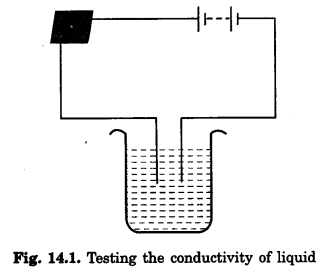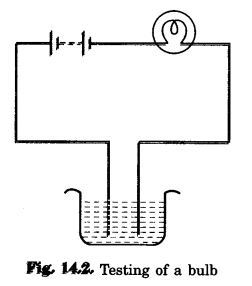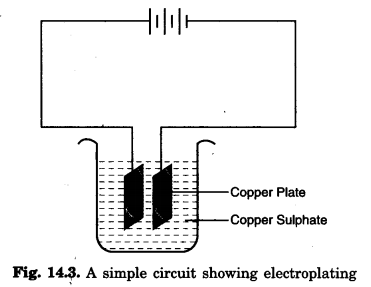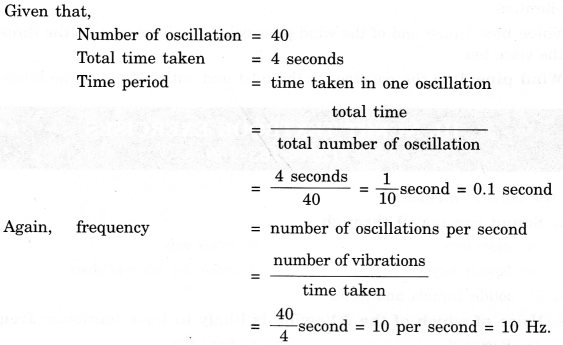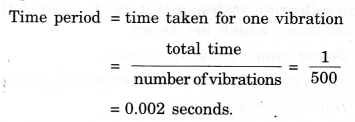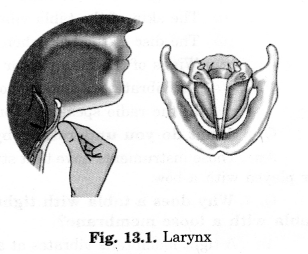NCERT Solutions for Class 8 Science Chapter 16 Light are part of NCERT Solutions for Class 8 Science. Here we have given NCERT Solutions for Class 8 Science Chapter 16 Light.
| Board | CBSE |
| Textbook | NCERT |
| Class | Class 8 |
| Subject | Science |
| Chapter | Chapter 16 |
| Chapter Name | Light |
| Number of Questions Solved | 17 |
| Category | NCERT Solutions |
NCERT Solutions for Class 8 Science Chapter 16 Light
NCERT TEXTBOOK EXERCISES
Question 1.
Suppose you are in a dark room. Can you see objects in the room? Can you see objects outside the room? Explain.
Answer.
We cannot see objects in the darkroom. But, we can see objects outside the room, in case there is light outside the room. It is so because to see an object, we need light which gets reflected from the object and enters our eyes.
Question 2.
Differentiate between regular and diffused reflection. Does diffused reflection mean the failure of the laws of reflection?
Answer.
| Regular reflection | Diffused reflection |
1. Occurs from shiny and smooth surfaces. | 1. Occurs from unpolished and rough surfaces. |
No, diffused reflection does not mean, failure of the laws of reflection. It is due to irregularities in the reflecting surface, like that of cardboard.
Question 3.
Mention against each of the following whether regular or diffused reflection will take place when a beam of light strikes. Justify your answer in each case.
- Polished wooden table
- Chalk powder
- Cardboard surface
- Marble floor with water spread over it
- Mirror
- Piece of paper
Answer.
- Polished Wooden Table: Regular reflection will take place. This is because a polished wooden table will have a plane surface.
- Chalk Powder: Diffused reflection because the surface of the chalk powder is not smooth.
- Cardboard Surface: Diffused reflection since cardboard has a rough surface,
- Marble Floor with Water Spread Over it: Regular reflection as it will act as a plane surface.
- Mirror: Regular reflection because the mirror has a shiny surface which is even.
- Piece of Paper: Diffused reflection because the surface of the paper is rough.
Question 4.
State the laws of reflection.
Answer.
The laws of reflection are as follows:
- The angle of reflection is equal to the angle of incidence.
- The incident ray, the normal at the point of incidence, and the reflected ray all lie in the same plane.
Question 5.
Describe an activity to show that the incident ray, the reflected ray, and the normal at the point of incidence lie in the same plane.
Answer.
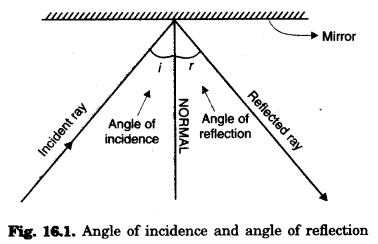
Question 6.
Fill in the blanks in the following:
- A person 1 m in front of a plane mirror seems to be…….. m away from his image.
- If you touch your………..ear with your right hand in front of a plane mirror it will be seen in the mirror that your right ear is touched with
- The size of the pupil becomes………………..when you see in dim light.
- Night birds have…………..cones than rods in their eyes.
Answer.
- 2
- left, left hand
- large
- lesser (fewer).
Choose the correct option in Questions 7 and 8.
Question 7.
The angle of incidence is equal to the angle of reflection:
(a) Always
(b) Sometimes
(c) Under special conditions
(d) Never
Answer.
(a) Always.
Question 8.
The image formed by a plane mirror is
(a) virtual, behind the mirror and enlarged,
(b) virtual, behind the mirror and of the same size as the object.
(c) real at the surface of the mirror and enlarged.
(d) real, behind the mirror and of the same size as the object.
Answer.
(b) Virtual, behind the mirror and of the same size as the object.
Question 9.
Describe the construction of a kaleidoscope.
Answer.
A kaleidoscope is an optical instrument used to see a number of beautiful patterns. It is made up of a circular cardboard tube or tube of thick chart paper in which rectangular mirror strips are joined together to form a prism. At one end of the tube, touching these mirrors, a circular plane glass plate is fixed and several, small pieces of colored glass (broken pieces of colored bangles) are placed upon it. This end is closed by a ground glass plate and beautiful patterns are seen through the other end of the kaleidoscope.
Question 10.
Draw a labelled sketch of the human eye.
Answer.
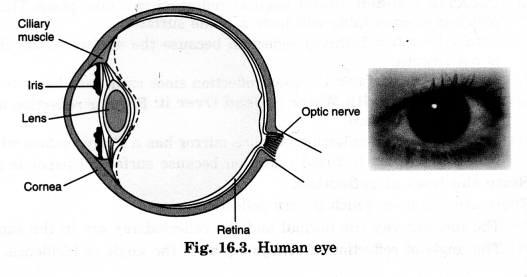
Question 11.
Gurmit wanted to perform, activity 16.8 (NCERT) using a laser torch. Her teacher advised her not to do so. Can you explain the basis of the teacher’s advice?
Answer.
Laser rays can cause a permanent defect in the eye. Thus, his friend will lose her eyesight if a laser torch is directed over her eyes.
Question 12.
Explain how you can take care of your eyes.
Answer.
The following measures should be taken to keep our eyes healthy and free from any defect:
- We should not look at the sun or a powerful light source directly.
- We should not try to see in too little or too much light. It is bad for the eyes. Insufficient light causes eye strain and headaches.
- Too much light, like that of the sun, or powerful lamps, can injure the retina, which is very delicate.
- If advised, suitable spectacles should be used.
- We should wash our eyes frequently with clean water.
- We should always read from a normal distance for distinct vision and not by bringing the book too close or keeping it too far.
- We should never rub our eyes if any small particle of dust goes into the eyes. Instead, eyes should be washed with clean water and if the condition does not improve, a doctor should be consulted.
- If food is deficient in some components, the eye may also suffer. Lack of vitamin A in our diet is responsible for many eye troubles. Most common amongst thorns is night blindness. Therefore, to get rid of this, we must include in our diet components that have vitamin A.
Question 13.
What is the angle of incidence of a ray if the reflected ray is at an angle of 90° to the incident ray?
Answer.
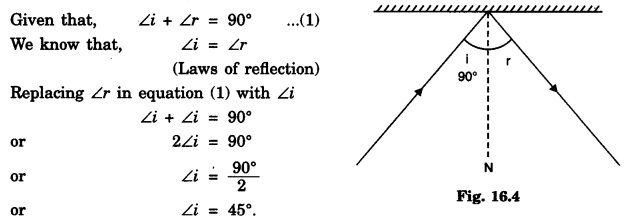
Question 14.
How many images of a candle will be formed if it is placed between two parallel plane mirrors separated by 40 cm?
Answer.
The infinite number of images of the candle will be formed if it is placed between two parallel plane mirrors.
Question 15.
Two mirrors meet at right angles. A ray of light is incident on one at an angle of 30° as shown in Fig. 16.5. Draw the reflected ray from the second mirror.

Answer.
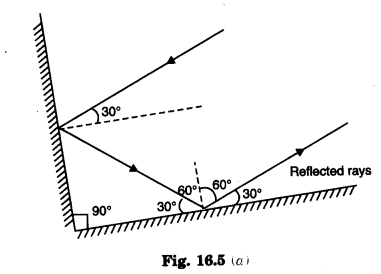
Question 16.
Boojho stands at A just on the side of a plane mirror as shown in Fig. 16.6.
Can he see himself in the mirror? Also can he see the image of objects situated at P, Q and R?
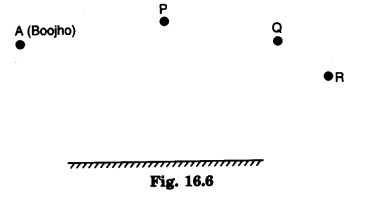
Answer.
No, He can see images of objects at P but not of Q and R.

Question 17.
(a) Find out the position of the image of an object situated at A in the plane mirror (Fig. 16.7).
(b) Can Paheli at B see this image?
(c) Can Boojho at C see this image?
(d) When Paheli moves from B to C, where does the image of A move?
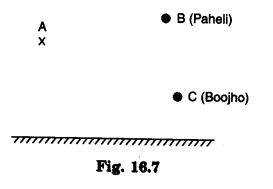
Answer.
(a) Fig. 16.7 (a)
(b) Yes
(c) Yes
(d) No change as the position of A is not changing
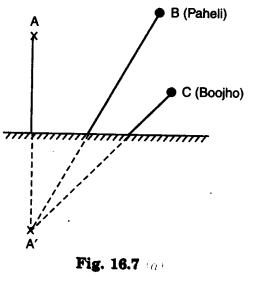
We hope the NCERT Solutions for Class 8 Science Chapter 16 Light helps you. If you have any query regarding NCERT Solutions for Class 8 Science Chapter 16 Light, drop a comment below and we will get back to you at the earliest.
